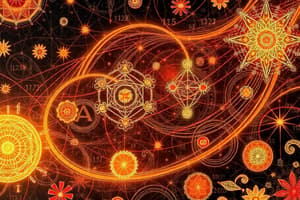Podcast
Questions and Answers
What is an atom?
What is an atom?
Basic unit of matter, made up of 3 subatomic particles.
What does the nucleus contain?
What does the nucleus contain?
Protons and neutrons.
What do electrons do?
What do electrons do?
Move around the nucleus.
What is the atomic number?
What is the atomic number?
What is a chemical element?
What is a chemical element?
What is an element?
What is an element?
What are isotopes?
What are isotopes?
What is a compound?
What is a compound?
What are chemical bonds?
What are chemical bonds?
What are valence electrons?
What are valence electrons?
What happens in covalent bonds?
What happens in covalent bonds?
What happens in ionic bonds?
What happens in ionic bonds?
What is a molecule?
What is a molecule?
Flashcards are hidden until you start studying
Study Notes
Units of Matter
-
An atom is the fundamental unit of matter, composed of three subatomic particles: protons, neutrons, and electrons.
-
The nucleus is the core of an atom, housing protons (positively charged) and neutrons (neutral).
-
Electrons are negatively charged particles that orbit the nucleus in defined energy levels.
-
The atomic number uniquely identifies each element, representing the total number of protons in its atoms.
-
A chemical element is defined as a pure substance made entirely of one type of atom, such as oxygen or gold.
-
An element cannot be broken down into simpler substances by chemical means.
-
Isotopes refer to variations of the same element that have the same number of protons but different numbers of neutrons, leading to different mass numbers.
-
A compound forms when two or more elements chemically combine in fixed ratios, resulting in distinct properties from the individual elements.
-
Chemical bonds are the forces that hold atoms together within compounds, essential for forming stable structures.
-
Valence electrons are the outermost electrons of an atom, crucial for bonding as they can be shared or transferred to form chemical bonds.
-
Covalent bonds occur when electrons are shared between atoms, allowing them to fill their outermost electron shells.
-
Ionic bonds form when electrons are transferred from one atom to another, resulting in the creation of charged ions that attract each other.
-
A molecule is the smallest functional unit of a compound, containing two or more atoms bonded together either through covalent or ionic bonds.
Studying That Suits You
Use AI to generate personalized quizzes and flashcards to suit your learning preferences.




